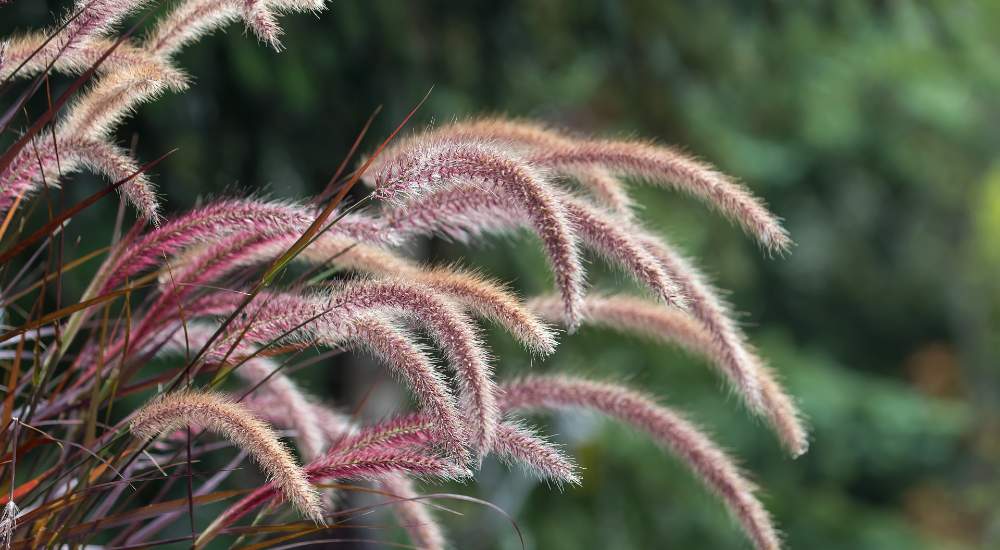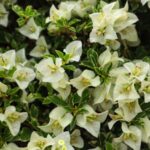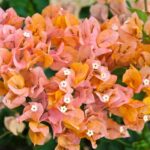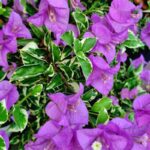While Red Fountain Grass may not be the most breathtaking plant in your yard, it certainly won’t be the least!
Normally when we hear the term “grass” we think of the short thin green leaves that cover our yard. But grass comes in many different varieties and can be used for a lot more than playing croquet.
We wanted to shine a little bit of line on this lesser known type of grass because we feel it makes a great addition to any Florida home landscape design.
But before our top uses for Red Fountain Grass and what makes it interesting… let’s make sure we’re both thinking of the same kind of fountain grass.
Types of Fountain Grass
There are tons of different types of fountain grass to choose from depending on what you need.
Some species only grow to be 12 inches tall, while others grow past 3 feet – making them too short to be privacy hedges.
The most common variety you see around Florida is called Hameln (P. alopecuroides ‘Hameln’). You’ll recognize it by its light tan color in the summer, and its pinkish brown in the fall.
This variety is a good choice if you live in the Midwest because it blooms earlier than the others. Here in Florida we have longer growing seasons so we can grow more exotic varieties.
Our focus today will be on Red Fountain Grass (P. setaceum ‘Rubrum’) which is known for its reddish foliage and fluffy flowers. It’s also one of the strongest growers, reaching up to 4 feet tall!
Other types of fountain grass that we might have in stock at our nursery include ‘Cassian,’ ‘Little Bunny,’ ‘Little Honey,’ and ‘Moudry.’
How to Identify Red Fountain Grass
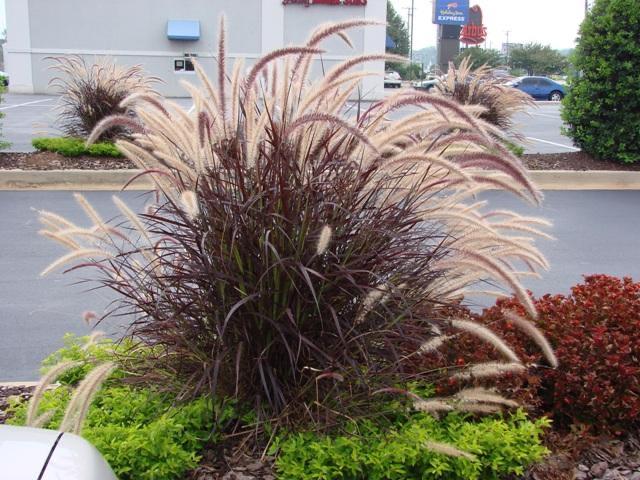
Red Fountain Grass grows in dense clumps 3 to 4 feet tall. Attractive green-tinged red to fully red foliage. The coppery-pink to purple-red flower plumes rarely set seeds.
Although it is a close relative of Buffelgrass, it has a much neater appearance.
The general family of this plant is easy to identify, knowing it’s the Red variety really just comes down to taking a closer look at its colors.
When the plant is dormant, it’s easy to confuse it with deer grass (Muhlenbergia regens), which has much thinner leaves and a narrower flower head.
Suggest Uses For Fountain Grass
Some of our landscape designs have included using fountain grass beside sun-loving prairie perennials like coneflowers and coreopsis.
For clients that wanted a more naturalistic garden, we mingled it among tall and medium annuals.
One final suggestion would be to consider blending it into large container plantings by using the tall plumes as a high point in the rear of the pot.
Does Red Fountain Grass Come Back Every Year?
This question is one of the reasons we specified Red Fountain Grass. There are some varieties of fountain grass (Pennisetum alopecuroides) that are perennial. You’ll typically find these types in the Midwest.
The variety this article focuses on is actually an annual fountain grass (aka Pennisetum setaceum). The reason you won’t find Red Fountain Grass in the Midwest is because it will not survive the winter.
Red Fountain Grass should be treated as an annual where winter temperatures dip below 10°F.
Red Fountain Grass Hardiness
Let’s go ahead and break down the hardiness of this plant in a little more detail. It’s considered winter hardy to USDA Zones 9-10… which means it can’t handle a frost.
Ideally, it would be grown in a medium moisture environment, with well-drained soil in full sun.
In Florida, it will survive winter and is typically grown as if it were a perennial. Although species plants can be grown from seed each year new plants are typically purchased from nurseries like ours each spring for planting in the garden after last spring’s frost date.
Technically plants can be dug in fall, trimmed and overwintered in greenhouses or indoors in sunny cool areas, but many gardeners simply prefer to purchase new plants each spring.
Plants may need some staking or other support and should be sited in areas protected from strong winds. Provide consistent water throughout the growing season.
Should Fountain Grass Be Cut Back In Winter?
The best time to trim Red Fountain Grass back is in the late winter or early spring. The exact timing is not as important as just making sure that you prune fountain grass back before it starts actively growing.
You want to avoid doing fountain grass pruning in the fall, as the plant has not yet died back all the way.
If you try to cut back fountain grass in the fall, you may cause it to go into a growth spurt, which will make it more vulnerable to the coming cold weather and will reduce its chances of surviving the winter.
Steps for Cutting Back Fountain Grass
Cutting back fountain grass couldn’t be easier! And taking the time to cut back fountain grass will result in a nicer looking “fountain” in the summer.
Step 1
When you trim fountain grass back is to tie up the dead stems. This is just to make the chore of cutting back fountain grass a little easier because you won’t have to clean up all the fallen stems.
Step 2
The next step in fountain grass pruning is to use a cutting tool, such as pruning shears or hedge clippers, to cut back the stem bundle. Prune your Red Fountain Grass about 4 to 6 inches above the ground. The remaining stems will be quickly hidden under the new growth.
That’s all there is to it!
How Did It Get To The US?
Fountain Grass is originally from Africa. It wasn’t until 1880 that fountain grass seed was first available in the US. Decades later in 1940 it began to be cultivated as an ornamental plant in Tucson.
As the plant tends to do, it started to spread pretty quickly. Records show that fountain grass began establishing itself in the Santa Catalina Mountains north of Tucson as early as 1946.
Nowadays, fountain grass of all varieties are sold in nurseries for gardens and landscapes. The seeds are spread by wind, water, and by animals and humans.
Where to buy Red Fountain Grass?
Take advantage of these Red Fountain Grass care tips by raising some plants of your own!
Visit our nursery at Troy Tropics and turn your backyard into an outdoor paradise.
Our team of greenery experts can help you decide on the best plants for your home.
Contact us through our online form or call us directly at (941) 212-1671.

